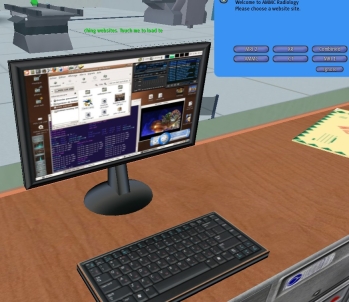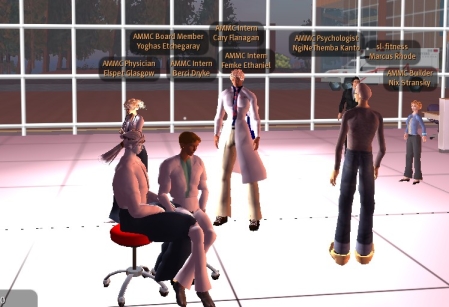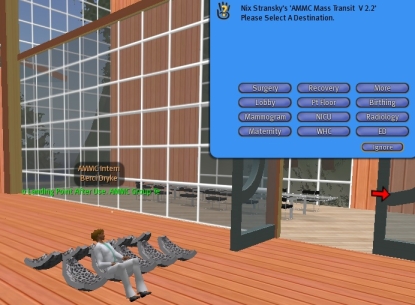The DNA Network |
| Posted: 14 Jul 2008 05:35 PM CDT |
| Personalized Genetics: Selfome [ScienceRoll] Posted: 14 Jul 2008 04:52 PM CDT It’s not about genomes and proteomes any more. Personalized genetics leads to a strange field called selfome where an individual is in the focus. Just take a look at the Quantified Self project, the first personal genome user group. There are some quite interesting opinions in the blogosphere I would like to share with you. Allie Janson thinks there should be a distinction between recreational and medical genetics.
Tim O’Reilly, the father of web 2.0, also has something to say about personal genomics companies selling tests directly to consumers:
Jennifer Mccabe Gorman and Matthew Holt attended the US DHHS Meeting on Consumer-Direct Genome Sequencing. Conclusion: We need a high-tech patient advocate service. Yes, and we need doctors who are trained to understand the main problems of personalized genetics. We need a whole generation of doctors who can tell the patients properly about their risks for diseases. To show you a peer-reviewed article as well, here is a recent publication of NEJM, Polygenes, Risk Prediction, and Targeted Prevention of Breast Cancer. And do you know how much data your genome is?  |
| Why Health or Medicine 2.0? [ScienceRoll] Posted: 14 Jul 2008 03:32 PM CDT Some interesting statistics have recently been published. According to Pharma 2.0:
At The Deloitte Center, you will find even more details about the web usage of health consumers. Yes, there will be much more patients who seek health-related information on the web and who want to communicate with their doctors via e-mail or Skype. And if a doctor thinks like that:
How will he answer the questions about reliable medical online resources? No, the basics of practicing medicine will never change dramatically due to new technologies or the web. But it will change the way it is practiced. Not because it is so important or so overhyped, but because patients will need this kind of knowledge and expertise. This will happen either you like it or not. And physicians of the 21st century must be ready and qualified to meet these expectations. And yes, we have innovators who can show us new ways, such as Jay Parkinson. We have tools to work with: And we have concepts. I believe, with opportunities of web 2.0, we can totally change medical education; we can build careers and we can develop a more efficient communication. Health 2.0 will reform healthcare itself; medicine 2.0 will do the same with education. Or is already doing… Do you still believe it is just a bubble?  |
| Experimental Physics a la Canadien (or Canuck Anthropology?) [Bayblab] Posted: 14 Jul 2008 02:52 PM CDT OK, so we don't always get the calculations right. But you can't say we don't give it our all. This video of Kenny Powers' attempted cross-border "Superjump" over the 1 mile wide St. Laurent river is classic Canadiana all the way. As are the sweet custom mods on his pimped-out, jet-powered, Lincoln Continental. You can bet this idea was conceived after way too many cases of Labatt's 50. And it's certainly a cultural relic you won't find the likes of in post-NAFTA Canadia! Popular Science has a breakdown of the physics: "If, as the narrator informs us, the car achieves a takeoff speed of 280 mph, then using the equations of projectile motion, we can easily calculate that without air resistance (estimating a launch angle of about 30 degrees) the maximum distance the car could achieve is around 1500 meters, or just short of a mile. (I'll leave it to those of you with a little physics background to confirm this is true.) However, at speeds of this magnitude, air resistance will have a major effect on the flight of the car. The force of air resistance is proportional to the square of the velocity, so if you double the speed you quadruple the air resistance. Incorporating the effect of air drag into the calculations we find that Kenny won't even make it a quarter of a mile before falling ignominiously into the river." Ooo. A little harsh. Come on guys, hind-sight's 20-20 right? Anyway, check out the video and judge Kenny's physics for yourself: Further reading: For those unfamiliar with the psychology of the male Canadien and/or interested in further exploring Canadian anthropology through the miracle of YouTube Video, see also The Best Of Ron Hextall, Canadiens vs Nordiques 'Good Friday brawl' 1984, The Never-Ending Bench Clearing Brawl of Canada vs Russia 1987 at the World Juniors, the seminal National Film Board of Canada mockumentary "FUBAR", and Canadian television favorite "The Trailer Park Boys". |
| Things to update on Genomicron -- what dontcha like? [T Ryan Gregory's column] Posted: 14 Jul 2008 02:50 PM CDT Scientific Blogging is a work in progress and lots of neat features (some of which are visible, some are not) are being incorporated continually. As things move forward, it is helpful to bug the powers that be to fix things that we don't like and to include things that we do. So, in this comment thread, please NICELY point out things that you would like to see updated or changed. |
| Posted: 14 Jul 2008 02:40 PM CDT |
| Evolution: Education and Outreach online [T Ryan Gregory's column] Posted: 14 Jul 2008 02:18 PM CDT
|
| New Educational Tools in Second Life [ScienceRoll] Posted: 14 Jul 2008 10:47 AM CDT In Second Life, we have some new tools and gadgets to work with at the Ann Myers Medical Center. I would like to share some examples with you and if you’re interested, I would love to be your guide inside the virtual world. Radiology room: There is a laptop with plenty of educational resources. If you click on it, you can choose which field you are interested in. Then you can access multiple websites focusing on medical quizzes and radiological images on the browser of SL. A group of Dutch physicians wanted to see more on the site so we showed them around. At this point, the equipment has no useful function, but we plan to upload CT images (among others) Cardiology: Now there are two chairs (one for a doctor and one for a patient) where we can listen to cardiac murmurs or lung sounds: And one more thing. As we often have groups looking around at the center, now (thanks to our builder, Nixx) we can use group teleportation as well. Further reading:
 |
| Blogger writes journal article about blogs about journal articles. [T Ryan Gregory's column] Posted: 14 Jul 2008 09:39 AM CDT Or something. See the paper |
| The Trip Part IV - Bavaria [The Daily Transcript] Posted: 14 Jul 2008 08:37 AM CDT After Paris we flew to Munich on Airberlin (20Euros per ticket, 50Euros after taxes and airport fees.) There we met up with some former colleagues (Julia and Michael) and a current member of the Rapoport Lab (Briana) who will be leaving us soon to start her own lab in the MCB department at Harvard's Main Campus. Also in attendance was Briana's husband and my wife who snapped this picture of us in the English Garden.
Munich is a beautiful city. For anyone who enjoys the music, Munich might as well be the world capitol of classical music. The number of great performers who currently live in-and-around the city is astonishing.
The university is also known for the White Rose, a non-violent anti-Nazi group. They waged a campaign against Hitler's policies and were eventually caught. Beneath the fold I'll describe a famous and tragic event. Read the rest of this post... | Read the comments on this post... |
| Young Scientists [Sciencebase Science Blog] Posted: 14 Jul 2008 07:00 AM CDT
You probably saw the recent news about a 13-year old boy from Germany, taking part in a science festival, who corrected NASA calculations on the likely impact of asteroid Apophis, shortening the odds of a killer collision with Earth. Agence France Press reported it as follows: NASA had previously estimated the chances at only 1 in 45,000 but told its sister organisation, the European Space Agency (ESA), that the young whizzkid had got it right. Prior to that there was the case of the 17-year old Ottawa high school student who, while contributing to a science fair, apparently invented a way to identify and cure influenza. A team of ten students, won second prize for identifying genes that help plants thrive in salty soil, while third prize went to a 15-year-old in the same competition for her discovery of a human gene variation that may help in dealing with bipolar disorder. (More on science comp here). Then there was the Manitoba student who received the first-ever Triple Crown for high school science with a project finding alternatives to chemotherapy in the fight against cancer, winning first-place finishes in biotech-industry sponsored national challenge. There’s the teen inventor who came up with a new way to make biodegradable plastic bags. And, of course, who could forget the 11-year old who invented a diabetic dress for her sister. Then there’s the six-year old who discovered rare pterosaur bones on the Isle of Wight. One student even won a major science fair prize for a project entitled: “Identification, Characterization, and DNA Sequencing of the Homo Sapiens and Mus Musculus COL20A1 Gene (Type XX Collagen) with Bioinformatics and Polymerase Chain Reaction (PCR)”, which makes squeezing an egg into a bottle seem a little trivial to say the least. Schoolboy boffin beating cancer, cracking computer codes, finding life on Mars? You got it! The list goes on. There are so many teenage geniuses out there. Now, is it just me being a cynical old hack with an insider’s view of the media and public relations industries, or does this strike anyone else as odd? All these instances of child prodigies in science, have seemingly achieved what international research teams with industry and academic funding cannot seem to, all for the sake of a science fair or with some direct link to another organisation seeking publicity. Indeed, many of While I don’t wish to disrepect the efforts and achievements of any of the students taking part in science fairs and working hard to put together a great project, I wonder just how many of these so-called breakthroughs ever come to anything more than a framed certificate and a nice fat payout from the industry sponsor. Of course, one might level the same criticism at countless science projects being undertaken by adults on a professional basis the world over. Meanwhile, Jessica Shepherd writing in The Guardian reports that science exams really are more difficult than the arts and humanities exams, and researchers at the UK’s Durham University have the data to prove it. Apparently, there were “substantial differences in the average grades achieved by the same or comparable candidates.” But, according to the Royal Society of Chemistry, “There is now clear evidence of an alarming gap between the high-quality teaching and curriculum material presently available for science lessons in schools in the UK , and the corresponding simplistic questions being set in national examinations for 14 year-olds.” RSC spokesman Brian Emsley gave me several examples of just how tough the science questions can be at this age, for example:
One final question Emsley showed me, reminded me of a silly anecdote about vermin and compost heaps and asked: What powers a solar-powered mole-scarer? “Vast sums of money are being spent by government, industry and other educational bodies to enhance the excitement and delivery of STEM subjects, covering science, technology, engineering and mathematics,” according to the RSC, “but this is being negated by examiners who are reinforcing low expectations, and setting the standards that the weaker schools teach to.” So, one the one hand, we have a global public relations system marketing high school students as geniuses because they use some big words in a science fair project and yet, there is a major disparity between what these children are learning at school and how they are being tested. So, who are the geniuses here? Answer (a), (b), or (c). A post from David Bradley Science Writer |
| The Chinese are Coming… to Grad School [Bitesize Bio] Posted: 14 Jul 2008 05:39 AM CDT Did you know that it is more likely that the next graduate student you meet in the US is from one of two Chinese alma mater’s than from any other U.S. university, including UC Berkeley, Cornell University, and the University of Michigan, Ann Arbor? That’s a striking figure, the topic of a tiny comment in last week’s Science: Top Ph.D. Feeder Schools Are Now Chinese. While I may not have known that statistic however, it’s not surprising, as any past or current graduate student will tell you. There are a lot of non-American’s in American grad schools. Props to those non-Americans - they worked hard and have earned it.
People from the developing world however, view advanced education of the sort obtained with a Ph.D. as more of a means to the American Dream than Americans do, I think. I also think that the education level of a population is a strong indicator of its long-term posterity. This is why I am concerned, as an American. The level of interest in advanced degrees may very well be a bellwether for decades to come, when the current generation of American undergraduates become its leaders. Or maybe I’m over-reacting, overvaluing the Ph.D. sheepskin on my wall and the walls of my colleagues. What say you? |
| When you know the Books are Cooked [The Gene Sherpa: Personalized Medicine and You] Posted: 14 Jul 2008 03:38 AM CDT |
| Telehealth at Home with Genesis DM [ScienceRoll] Posted: 14 Jul 2008 02:46 AM CDT Genesis™ DM telehealth device from Honeywell HomMed (Brookfield, WI), one of the winners of 2008 Medical Design Excellence Awards, aims to help people living with long term health conditions, such as COPD or chronic heart failure, to maintain and monitor their health. In addition, the device was designed to help patients keep track of medical appointments and other important events.
Product page: Honeywell HomMed Genesis™ DM remote patient care monitor… This is a cross-post with Medgadget….  |
| Doggie ancestry [Yann Klimentidis' Weblog] Posted: 13 Jul 2008 11:06 PM CDT I heard about this, but never saw the details:  From the website of Doggie DNAPrint: From the website of Doggie DNAPrint:For example, in 2004 Parker et al. sequenced 75 SNP and 96 microsatellite loci in 85 dog breeds and showed that modern dog breeds are distinct genetic units and that breed can be accurately determined from dog DNA. Looking back relatively far in the dog family tree, Parker et al. noted that there appear to be 4 main dog breed types: |
| Seed Magazine Cribsheet #16: Synthetic Biology [] Posted: 13 Jul 2008 10:46 PM CDT
Probably the single most useful page we’ve ever seen for a quick understanding of the potentialities of Biotechnology. We love it. Seed Magazine is an awesome publication. Quote: “The Key Question of Synthetic Biology: Can we learn to program DNA and living organisms as well as or better than we currently program computers?” |
| Stanford - Promoting open access while selling access to "closed" journals [The Tree of Life] Posted: 13 Jul 2008 10:34 PM CDT Some people may have seen the press Stanford got a few weeks ago regarding the Open Access initiative of their School of Education. For some more information on this see Certainly sounds like a good move on their part. And then I got an interesting thing in the mail from the Stanford Alumni Association (I earned my PhD from Stanford) trying to get me to join the association (see letter below). What was the selling point? If I joined I would get access to newspapers, periodicals and even scientific journals, through their library. So Stanford is all for OA in some places. But while they have access to closed journals, they will use that as a recruitment tool to join the Alumni Association. Seems to me like a better way to push for Open Access would be for all of Stanford to take the School of Education's position and for the university to immediately cancel all subscriptions to completely closed access journals. |
| Posted: 13 Jul 2008 09:35 PM CDT |
| Saving Money and Gas and the Planet by Not Travelling [The Tree of Life] Posted: 13 Jul 2008 07:00 PM CDT A UC Davis professor has been getting some local press for NOT going to a meeting . Well, OK that is not exactly the point. He (Timothy Morton) gave his talk remotely by video taping it and then having the people in Scotland watch the DVD and then talk to him. The reason for the news coverage is that by doing this this saves both money and carbon output. Given that I have been canceling trips left and right recently for some medical reasons, I like this idea. I even gave a talk over iChat to a metagenomics gathering in Berlin that was organized by Dan Falush. I was supposed to go to to this workshop last week as a run up for the International Congress of Genetics (which I have also bailed on but they did not offer to let me speak remotely). I might add that doing a talk by iChat worked out OK ... we probably needed speakers for the computer on the other end and microphones so I could hear the discussion. And not sure my talk was any good. But technically, iChat worked out fine. So what I am now going to say is that I am canceling the trips for environmental reasons ... |
| You are subscribed to email updates from The DNA Network To stop receiving these emails, you may unsubscribe now. | Email Delivery powered by FeedBurner |
| Inbox too full? | |
| If you prefer to unsubscribe via postal mail, write to: The DNA Network, c/o FeedBurner, 20 W Kinzie, 9th Floor, Chicago IL USA 60610 | |






 As many of you are aware, a new journal entitled
As many of you are aware, a new journal entitled 






 Children are so bright these days. Allegedly. It seems that not a week goes by without some juvenile prodigy whizzkid, or child genius solving an engineering problem, revising some scientific data or inventing some world-saving gadget.
Children are so bright these days. Allegedly. It seems that not a week goes by without some juvenile prodigy whizzkid, or child genius solving an engineering problem, revising some scientific data or inventing some world-saving gadget.




No comments:
Post a Comment